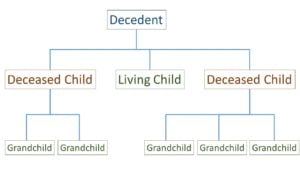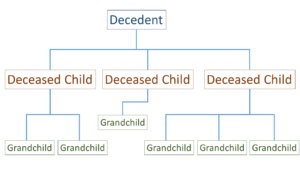The phrase “in equal shares per stirpes” is a common term in estate planning documents, but fraught with ambiguity. The recent case of Archer v. Moody, 544 S.W. 3d 413 (Tex. Ct. App. 2017) illustrates the problem with the phrase.
What Does Per Stirpes Mean?
This term, derived from the civil law, is much used in the law of descents and distribution, and denotes that method of dividing an intestate estate where a class or group of distributees take the share which their stock (a deceased ancestor) would have been entitled to, taking thus by their right of representing such ancestor, and not as so many individuals; while other heirs, who stand in equal degree with such ancestor to the decedent, take each a share equal to his.
Black’s Law Dictionary.
Traditional per stirpes means that the children of a deceased parent divide up their parent’s share.

In the above example, the living child would take one-third of the estate, while the two children of the first deceased child would each take on-half of their parent’s share, which would be one-sixth each. The three children of the deceased child would each take one-third of their parent’s share, which would be one-ninth each.
In the following example, all three children are predeceased.

Traditional per stirpes would give each grandchild their share of their parent’s share. The children of the first deceased parent would each get one-sixth, the sole child of the second deceased parent would receive one-third, and the children of the third deceased parent would each get one-ninth.
Some states have adopted a modern, or modified version of per stirpes by statute, so that when all beneficiaries are of the same generation, they each get the same share. So in the example above, each grandchild would receive a one-sixth share. Another version of per stirpes would give equal shares to each beneficiary of the same generation, whether or not there are other beneficiaries at different generations. In the first diagram, this would mean that the living child receives one-third of the estate, and the five grandchildren would each receive one-fifth of the two-thirds available for the grandchildren, or 2/15’s for each of the five grandchildren.
Better drafting can ensure that the testator’s intent is fulfilled. If the testator wants traditional per stirpes, the phrase “to my children in equal shares with right of representation” will have no ambiguity as to the testator’s intent.
In the Archer case, the settlor had three children and eight grandchildren. Four of the grandchildren were through the settlor’s son, and the settlor’s two daughters each had two children. Traditional per stirpes would create three shares, one share for each parent’s children. The son’s children would each receive one-twelfth of the trust, and the four grandchildren through the daughters would each receive one-sixth of the trust.
The language in Archer stated that the trust was to be divided as follows:
.. [T]he Trustee shall, upon the termination of the Trust, distribute the Trust Estate in equal shares per stirpes to the then living grandchildren of William Lewis Moody, III, and the surviving issue of his deceased grandchildren.
The lower court held that this meant equality among all of the grandchildren, meaning each received the same share.
The appellate court reached the opposite conclusion, applying a strict, traditional definition of per stirpes, as follows:
“Per stirpes” is defined as “[p]roportionately divided between beneficiaries according to their deceased ancestor’s share.” Per stirpes, Black’s Law Dictionary (10th ed. 2014). The grandchildren are descendants of W.L. Moody, III’s three children: Edna Moody, Virginia Moody, and Bill Moody. By instructing that the trust estate be disbursed to W.L. Moody, III’s grandchildren “in equal shares per stirpes,” Article III contemplates a distribution to the grandchildren dependent on their deceased ancestor’s share. See id. The deceased ancestors here are Edna Moody, Virginia Moody, and Bill Moody. See also In re Estate of Williams, No. 08-98-00144-CV, 2000 WL 1053857, at *3 n.2 (Tex. App. — El Paso Aug. 1, 2000, no pet.) (not designated for publication) (citing Black’s Law Dictionary definition of “per stirpes,” court stated that “[t]he use of the term `per stirpes’ demonstrates the intent that the descendants… would take by representation”); Parrish v. Mills, 102 S.W. 184, 188 (Tex. Civ. App. — Austin 1907), aff’d, 101 Tex. 276, 106 S.W. 882 (Tex. 1908) (defined “per stirpes” as meaning “to take by stock or through a common source, and, when applied to estates, signifies that the particular descendants shall take among themselves the share of their deceased parent”).
The obvious problem with the drafting is that the phrase “in equal shares per stirpes to the then living grandchildren” could mean equal shares to the grandchildren, or classic per stirpes, but not both. The phrase “equal shares” should never be added to the phrase “per stirpes,” because each phrase could be construed as directing the opposite of the other phrase.





